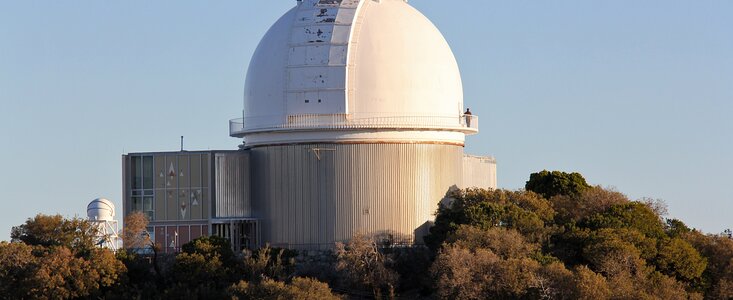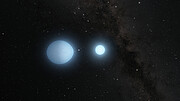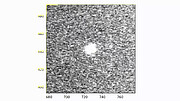Found: fastest eclipsing binary
A valuable target for gravitational wave studies
24 July 2019
Observations made with a new instrument developed for use at the 2.1-meter (84-inch) telescope at the National Science Foundation’s Kitt Peak National Observatory have led to the discovery of the fastest eclipsing white dwarf binary yet known. Clocking in with an orbital period of only 6.91 minutes, the rapidly orbiting stars are expected to be one of the strongest sources of gravitational waves detectable with LISA, the future space-based gravitational wave detector.
The Dense “Afterlives” of Stars
After expanding into a red giant at the end of its life, a star like the Sun will eventually evolve into a dense white dwarf, an object with a mass like that of the Sun squashed down to a size comparable to Earth. Similarly, as binary stars evolve, they can engulf their companion in the red giant phase and spiral close together, eventually leaving behind a close white dwarf binary. White dwarf binaries with very tight orbits are expected to be strong sources of gravitational wave radiation. Although anticipated to be relatively common, such systems have proven elusive, with only a few identified to date.
Record-setting White Dwarf Binary
A new survey of the night sky, currently underway at Palomar Observatory and Kitt Peak National Observatory, is changing this situation.
Each night, Caltech’s Zwicky Transient Facility (ZTF), a survey that uses the 48-inch telescope at Palomar Observatory, scans the sky for objects that move, blink, or otherwise vary in brightness. Promising candidates are followed up with a new instrument, the Kitt Peak 84-inch Electron Multiplying Demonstrator (KPED), at the Kitt Peak 2.1-meter telescope to identify short period eclipsing binaries. KPED is designed to measure with speed and sensitivity the changing brightness of celestial sources.
This approach has led to the discovery of ZTF J1539+5027 (or J1539 for short), a white dwarf eclipsing binary with the shortest period known to date, a mere 6.91 minutes. The stars orbit so close together that the entire system could fit within the diameter of the planet Saturn.
“As the dimmer star passes in front of the brighter one, it blocks most of the light, resulting in the seven-minute blinking pattern we see in the ZTF data,” explains Caltech graduate student Kevin Burdge, lead author of the paper reporting the discovery, which appears in today’s issue of the journal Nature.
A Strong Source of Gravitational Waves
Closely orbiting white dwarfs are predicted to spiral together closer and faster, as the system loses energy by emitting gravitational waves. J1539’s orbit is so tight that its orbital period is predicted to become measurably shorter after only a few years. Burdge’s team was able to confirm the prediction from general relativity of a shrinking orbit, by comparing their new results with archival data acquired over the past ten years.
J1539 is a rare gem. It is one of only a few known sources of gravitational waves—ripples in space and time—that will be detected by the future European space mission LISA (Laser Interferometer Space Antenna), which is expected to launch in 2034. LISA, in which NASA plays a role, will be similar to the National Science Foundation’s ground-based LIGO (Laser Interferometer Gravitational-wave Observatory), which made history in 2015 by making the first direct detection of gravitational waves from a pair of colliding black holes. LISA will detect gravitational waves from space at lower frequencies. J1539 is well matched to LISA; the 4.8 mHz gravitational wave frequency of J1539 is close to the peak of LISA’s sensitivity.
Discoveries Continue for Historic Telescope
Kitt Peak’s 2.1-meter telescope, the second major telescope to be constructed at the site, has been in continuous operation since 1964. Its history includes many important discoveries in astrophysics, such as the Lyman-alpha forest in quasar spectra, the first gravitational lens by a galaxy, the first pulsating white dwarf, and the first comprehensive study of the binary frequency of stars like the Sun. The latest result continues its venerable track record.
Lori Allen, Director of Kitt Peak National Observatory and Acting Director of NOAO says, “We’re thrilled to see that our 2.1-meter telescope, now more than 50 years old, remains a powerful platform for discovery.”
“These wonderful observations are further proof that cutting-edge science can be done on modest-sized telescopes like the 2.1-meter in the modern era,” adds Chris Davis, NSF Program Officer for NOAO.
More Thrills Ahead!
As remarkable as it is, J1539 was discovered with only a small portion of the data expected from ZTF. It was found in the ZTF team’s initial analysis of 10 million sources, whereas the project will eventually study more than a billion stars.
“Only months after coming online, ZTF astronomers have detected white dwarfs orbiting each other at a record pace,” says NSF Assistant Director for Mathematical and Physical Sciences, Anne Kinney. “It’s a discovery that will greatly improve our understanding of these systems, and it’s a taste of surprises yet to come.”
More information
“General relativistic orbital decay in a seven-minute-orbital-period eclipsing binary system,” Burdge et al. 2019, Nature, https://www.nature.com/articles/s41586-019-1403-0
Kitt Peak National Observatory (KPNO) is part of the National Optical Astronomy Observatory (NOAO), which is operated by the Association of Universities for Research in Astronomy (AURA) under a cooperative agreement with the National Science Foundation (NSF). NSF is an independent federal agency created by Congress in 1950 to promote the progress of science. NSF supports basic research and people to create knowledge that transforms the future. The NOAO community is honored to be permitted to conduct astronomical research on Iolkam Du’ag (Kitt Peak), a mountain with particular significance to the Tohono O’odham Nation.
Links
- “General relativistic orbital decay in a seven-minute-orbital-period eclipsing binary system,” Nature paper.
- Dead Stars Found Whipping Around Each Other in Minutes, Caltech Press Release.
- “Behind the Paper” details from the lead investigator, Kevin Burdge, on how the discovery was made and its implications.
Contacts
Dr. Lori Allen
Director, Kitt Peak National Observatory
Acting NOAO Director, National Optical Astronomy Observatory
Tel: +1 520-318-8281
Email: lallen@noao.edu
About the Release
| Release No.: | noao1906 |
| Legacy ID: | NOAO 19-07 |
| Facility: | KPNO 2.1-meter Telescope |
| Instruments: | KPED |
| Science data: | 2019Natur.571..528B |





